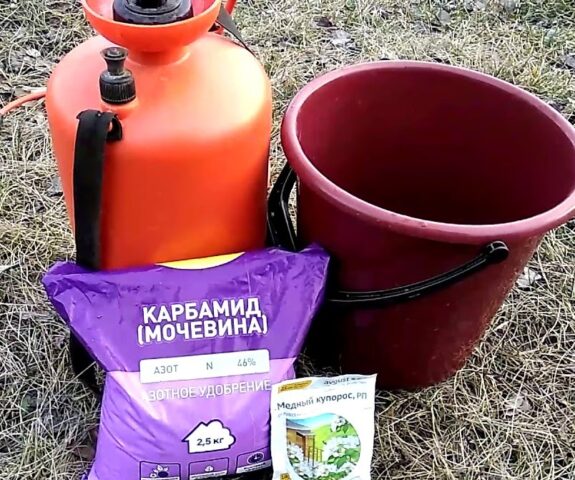Content
Grapes are a rather capricious and demanding crop when it comes to agricultural technology. An important component of its care is the application of fertilizers: without this, annual and abundant harvests may not be expected. Feeding grapes with urea is a simple and affordable way to provide them with nitrogen. But to prevent the substance from doing more harm to the vines than good, you need to know at what stage of the growing season to use urea, how to prepare the working solution and apply fertilizer.
Is it possible to feed grapes with urea?
Urea (also known as carbamide or carbonic acid diethylamide) is a universal mineral fertilizer used for feeding any fruit and ornamental garden crops by root and foliar methods. It is also suitable for grapes.
Urea is considered a “mono-fertilizer” and contains about 46% nitrogen in amide form. This fertilizing is successfully “absorbed” by the grapes.Once in the soil, the substance is first converted to ammonium, then to nitrate, in the process slightly reducing the concentration of the main ingredient. Accordingly, if the dosage is observed, there is no risk of “burning” the roots.
You can make the procedure even more effective by adding magnesium sulfate, compatible with carbamide. Also, the fertilizer does not “conflict” with the vast majority of insecticides, fungicides, and pesticides. On the contrary, their addition to the mixture increases the effectiveness of other chemicals, since urea provides greater “permeability” of tissues and better hydration of roots.

Urea is a substance in the form of small round white granules, non-toxic, odorless, easily soluble in water.
Why treat grapes with urea
Fertilizing grapes with urea in the spring is necessary to quickly “bring out” the vines from winter “hibernation” and to activate the process of formation of “high-quality” green mass - strong shoots, large leaves. Weak plants are not able to provide the gardener with a good harvest. In autumn, excess nitrogen is harmful to vines, but a high-concentration urea solution is used as a foliar fertilizer to protect grapes from pests and increase the cold resistance of plants.
Pros and cons of using urea for grapes
Provided the concentration of fertilizer in the solution is observed and the grapes are fed at the right time, urea will only bring benefits. Advantages of urea:
- the presence of vital nitrogen for grapes in high concentration and easily digestible form;
- the possibility of using urea as both root and foliar feeding;
- this is a “long-lasting” fertilizer;
- quick effect;
- suitability of urea for treating grapes in spring and autumn against diseases and pests;
- the ability to “work” in weakly and moderately acidic substrates;
- Possibility of mixing with drugs against pathogenic microflora and harmful insects.
In some cases, fertilizing grapes with urea will have to be abandoned. Accordingly, urea has not only advantages, but also disadvantages:
- if there is a deficiency of urease in the soil, fertilizing grapes will not give the desired effect;
- the fertilizer is highly hygroscopic;
- if grapes are fertilized with urea too often or its concentration in the working solution is exceeded, the vines begin to “fatten”;
- urea cannot be used for fertilizer in highly acidified or alkaline soil;
- 5-7 days should pass between the addition of urea and other agents.

The best effect of the fertilizer is achieved when the working solution penetrates to a depth of about 50 cm
When to treat grapes with urea
Spring root feeding of grapes with urea is carried out annually or at intervals of one season, depending on the type and quality of the soil, variety, age of the vines, and other factors. At the end of the growing season, the procedure is repeated every autumn.
Autumn treatment of grapes with urea
Spraying grapes with urea in the fall is carried out exclusively after harvest, when the vine has already dropped all or most of its leaves. Often, urea is used not in its “pure” form, but in a mixture with any fungicides in order to get rid of not only harmful insects, but also pathogenic microflora.

In the fall, fertilizing grapes with urea will not provoke the growth of new shoots
Spring treatment of grapes with urea
The timing of fertilization in the spring depends on the climate in the region. You need to wait until the night temperature is at least 5 °C. In areas with the most favorable growing conditions for the crop, this is approximately the second ten days of March. It is undesirable to be late in applying fertilizer - soon heavy spring rains begin, “washing out” nitrogen into the deeper layers of the soil, where it will no longer be useful for the roots of the vines.
To treat grapes with urea for the first time in the spring, the winter cover is not removed from the vines. It is only slightly opened, then restored to its original form. The second time the same fertilizer is applied approximately in mid-May - it is at this time that the vines shoots and leaves grow most actively.
The first feeding of grapes with urea in the spring is root feeding. During the second, the urea solution is not only watered, but also sprayed on the vine. This will help her absorb maximum nitrogen and get rid of pests and pathogens that are starting to become active.Although spraying grapes with urea in the spring against pests is not often practiced, at this time other preparations are used - “highly specialized” insecticides and fungicides. In most cases, gardeners postpone treatment with urea against pests until the fall.
In the absence of special pipes for watering grapes, the roots are “ringed” with a furrow with a diameter of about 50 cm and the nutrient solution is poured into it. Gardeners who grow many vines can fertilize the grapes with urea by digging a trench running parallel to their row on the trellis at a distance of 40-70 cm.

If it is planned to add humus to the tree trunk circle, this is done at least two weeks after feeding the grapes with urea
How to dilute urea
For root feeding of grapes, a 3-5% urea solution is prepared (in exceptional cases, its concentration can reach up to 7%). For foliar applications, its content is reduced to 1%. Treatment of vines against diseases and pests is carried out with a 6-7% solution. Accordingly, for 10 liters of water you will need from 100 to 700 g of urea. It is convenient to measure the required amount with a tablespoon - it contains about 10 g of granules.
Preparing fertilizer is extremely simple. Urea dissolves easily, so the required volume of granules is simply added to a container of water and stirred vigorously until they completely “disappear.”
To prepare a working solution of urea, use only settled water at room temperature.If it is too cold, urea takes longer to dissolve; if it is hard, it contains compounds of calcium, fluorine, and chlorine, which immediately react with it and reduce the effectiveness of the fertilizer.
Urea is completely safe for human health. Therefore, when working with it, you can do without personal respiratory and vision protection. The only exception when you should wear goggles, gloves and a respirator is if the solution is being prepared for the first time. Then it is advisable to conduct a “test for individual intolerance” by dropping a little liquid on the inside of the wrist or elbow. If after 15-20 minutes there is no negative reaction, the product is completely safe for humans.

It is advisable to use the working solution for feeding grapes immediately
How to treat grapes with urea
In order for the fertilizer to benefit the vines, it is necessary not only to choose the right processing time and prepare a solution of the required concentration, but also to avoid common mistakes. Often, beginning gardeners apply fertilizer superficially, simply pouring the solution around the tree trunk.
Such fertilizing with urea “inhibits” the ability of the vine to draw potassium and phosphorus from the soil, which are vital for the grapes to ripen the crop. Watering also provokes a “desire” of vine roots that usually go deep into the substrate to be closer to the surface. After improper feeding with urea, grapes become more susceptible to drought and cold.
Watering
It is impossible to specifically indicate the rate of solution. It is determined taking into account the age and dimensions of the vine. Equally important is her development last season. As a rule, the norm varies between 10-25 liters per bush.
If the growth rate of the vine was clearly slower than typical for the variety, the leaves turned yellow too early in the fall, the concentration of urea in the feeding solution increases to 6-7%. When, on the contrary, the leaf blades retained a green tint until late autumn and “stayed” on the vine, the urea content is reduced to 3-4%.
The solution is “introduced” into irrigation pipes or pre-prepared grooves. 10-15 minutes before this, a bucket of clean water is poured there. As soon as the solution “goes” completely into the pipe, the same amount is poured on top.
If grooves are used to feed grapes with urea, the soil is also moistened before and after applying the fertilizer. Every other day, when the top layer of soil dries, it is loosened to a depth of 8-10 cm.

For watering before and after fertilizing grapes with urea solution, it is advisable to use water heated to 28-30 °C
Spraying
Spraying is a less effective fertilizing than watering grapes with urea. Therefore, in the spring, when the goal is to provide the vines with nitrogen, they are carried out together. Applying fertilizer to the tree trunk circle mainly affects the green mass of the plant, while spraying affects its generative function.
If you regularly apply foliar feeding of grapes with urea in the fall, the total volume of the harvest, the size and sugar content of the berries increases. Urea also has a positive effect on the “eyes”, increasing their frost resistance.
For pests, urea is a poison that “burns” their surface protective shells. Insects deprived of them die from frost in winter. Treatment of vines against aphids, flower beetles, weevils, and honey beetles is especially effective.
Conclusion
Fertilizing grapes with urea is carried out mainly to stimulate the process of growing green mass. With a nitrogen deficiency, the vine forms a fragile stem and small, “flaccid” leaves. This, in turn, negatively affects the yield, size, and taste of the berries. In autumn, excess nitrogen in the soil is harmful for the vine; in such conditions it will not be able to prepare for winter. Shortly before the end of the growing season, fertilizer is applied to destroy pests at different stages of development that are going to overwinter in the tree trunk and on the plant itself.








